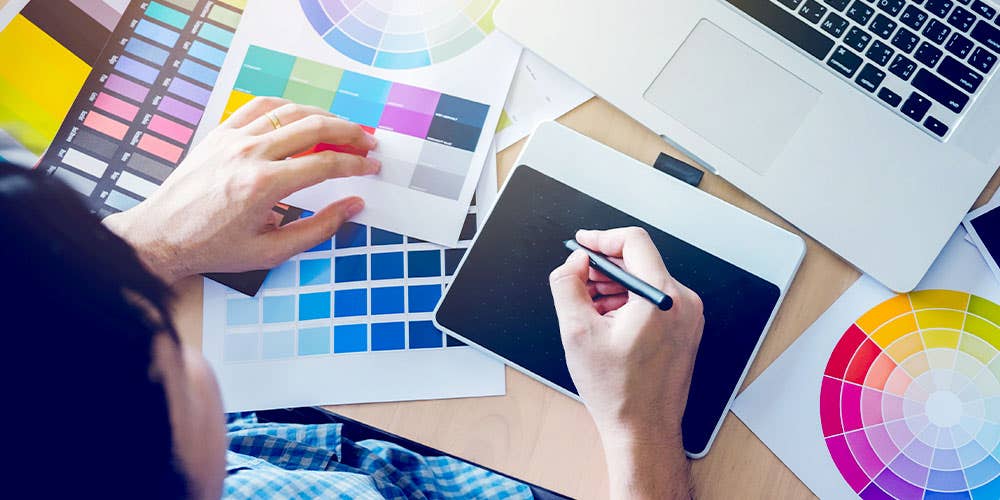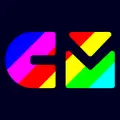Chat with Ava - Your AI Business Consultant
Hi I'm Ava, your AI guide to supercharging your business!
Whether you're already running a business or dreaming of starting one, I'm here to help turn your vision into reality using AI powered freelancers. Share your business goals, and together, we'll create a project that our talented freelancers can bid on. Let's make your vision a reality!
I have a business
I'm starting a business
Something went wrong while sending the conversation to your email. Please try again later.
You can only save your conversation once per hour. Please try again later.
Your conversation is too short. Keep chatting with Ava to enable saving.
How to design your brand identity
The secret to a winning website design is a winning brand identity. We show you how to create one
Nov 27, 2019 • 9 minute read
Updated on Dec 11, 2020 by Product Knowledge T.

Product Knowledge Specialist at Freelancer.com
Copy to clipboard failed, please try again after adjusting your permissions.
Copied to clipboard.

A solid brand identity is the foundation of a winning website design
The backbone of an irresistible website design is a well defined brand identity.
Designing your brand identity
Your brand identity is a representation of your business. It consists of all the visual elements that represent your business such as, color scheme, logo, topography and general attitude. Your brand identity makes your business easily recognisable to your customers, which encourages repeat business.
Let's perform an experiment on the effectiveness of brand identity.
Can you identify the brand this font belongs to?

That's right, it's the Coca Cola font.
Notice how just the font alone identifies the business it belongs to, that's evidence of a powerful brand identity.
A rookie error many business owners make when designing their website is to overlook the importance of brand identity design. The design of your website MUST be soaked in your brand identity, this is what differentiates beautiful website from 'meh' website.
A business' brand identity consists of the following elements:
Brand Personality
Logo
Slogan
Typography
Color scheme
Let's walk through the process of establishing each of these elements to create your unique brand identity.
Identifying your brand personality
The first step to creating a brand identity is to recognize its unique personality.
Many business owners make the mistake of attributing a brand personality that mirrors their own, but this does not necessarily resonate with customers.
When designing your brand personality, ask yourself this question:
"What type of personality would resonate with my target audience?"
By creating your brand personality through this perspective, it will be intentionally engineered to be loved by your prospective customers.
Featured Work in Graphic Design
Follow this procedure to identify your brand's personality:
1) Create a customer persona
Start by creating a customer persona to identify your ideal customer. Include details such as, occupation, likes dislikes, hobbies, aspirations, goals, frustrations.
The more granular you can get the easier it will be to create a suitable brand personality.
Here are a couple of examples:


2) Identify your brand's personality archetypes
With your customer persona complete, you can now create a brand personality they will resonate with.
Start by narrowing down your brand's personality archetype. Number the list of archetypes below from 10 to 1, with 1 being the most agreeable with your customer persona and 10 being the most disagreeable.
You can attribute the same score multiple times.

This list of archetypes are known as the 12 Jungian Archetypes .
To help you understand how they differ from one another, here is a brief summary of each archetype's motto:
1) Innocent - Free to be you and me
2) The Sage - The truth will set you free.
3) The Explorer - Don't fence me in.
4) The Outlaw - Rules are made to be broken.
5) The Magician - I make things happen
6) The Hero - Where there's a will there's a way
7) The Lover - You're the only one.
8) The Jester - You only live once.
9) The Everyman - All men and women are created equal
10) The Caregiver - Love your neighbour as yourself
11) The Ruler - Power isn't everything, it's the only thing.
12) The Creator / Artist - If you can imagine it, it can be done
When you have finished scoring each archetype, aim to narrow your top rated ones to no more than 3, if you can filter it down to 1, even better.
3) Describe your personality archetype(s).
Next you will need to come up with as many adjectives for each of your chosen archetypes as possible. The more adjectives you include, the more descriptive your archetypes will be.
Here is a list of brand appropriate adjectives you can use:

Your list of archetypes and adjectives should be structured like this:

You'll be surprised how vivid your brand personality will be after completing this exercise.
With this step completed, the design of your logo will be a relatively straightforward process.
Designing your business logo
Attribute images to your brand personality
If you were to design a logo for the the following adjective + archetype combination what would it be?
If you've never designed a logo before this will be a very difficult task because we are accustomed to thinking with words not graphics.
In this step you will be creating a set of graphics that represent your list of archetypes and adjectives to help you to start thinking about your brand personality graphically.

You can base your graphics off the archetype names, archetype mottos, adjectives or a combination of all. If you are a confident artist you can create sketches by hand, if not, google images is a great free tool you can use.
For example, for the archetype "Hero", Perform a Google image search with the term "icon" appended to the end of it, this will ensure only logo friendly results populate.
Here are the image results for "hero icon"

This also works for adjective images. Searching for the adjective "intellectual icon" yields the following results:

If you weren't sure how to design a logo representing intellectual heroism earlier, after viewing these image results, you might now be inspired with some creative ideas.
When you have finished saving all of your graphics, filter your set down to the few that most resonate with your brand personality, these will be the graphics you will use to create your final logo.
Create drafts of your logo
Now that you have a set of images, you can solely focus on them and disregard your worded descriptions and archetypes.
Your logo could be either be comprised of several of your final graphics fused together into a single image or separate individual graphics (just make sure you keep it simple and avoid overcrowding).
Here is an example of two different graphics being fused together to make a single image:

In this example, the archetype "caregiver" and adjectives "healthy" and "growing" are represented by combining the image of a human with a tree.
In this example, a single image is used to represent a single element of the brand rather than combining different images together:

If you prefer a heavier emphasis on your wording, you could incorporate a relevant graphic to replace one of the letters of your business name:

If you choose to include your business name in your logo you could compliment it with your business slogan (if it's short and sweet).
If you don't have a slogan (or value proposition), we walk you through the process of creating one in chapter 2 of our Ultimate Business Guide .
To further inspire your logo creation, you can peruse a gallery of previously completed professional logos.
Freelance Graphic Design Experts
Simply head over to our showcase page and click on the "logo tab" These designs will help you decide whether you prefer your logo to be more graphics focused or word focused.

When creating your logo drafts you can use the free online design tool Canva .
Here is a tutorial on how to create logos with Canva:
This step can be difficult if you have never designed a logo before. If you need assistance, our professional graphic designers are always available to help.
Aim to create about 10 different draft variations of your logo. To help you choose your final design make sure you ask a variety of people for advice (not just your mom).
When showing your draft variations to others, ask them how they would define your business based on each logo, this is most effective when receiving feedback from those that know little to nothing about your business.
The logo that receives the most up-votes and the most accurate descriptions of your business is the winner.
Designing your typography
This step is optional and can be skipped, however some businesses, such as Coca-Cola, prefer typography as their primary brand identifier.
Though not a primary brand identifier, Uber uses unique typography to differentiate their brand:

Keep in mind that unique typography is usually only used in the headlines and titles as in the Uber example above. To maximise readability, only standard fonts should be used for the body text.
The good news is that you don't need to design your typography from scratch, you can purchase a commercial license from an existing set.
Here is a list of font libraries you can use:
Google Fonts

Typography.com

Font Shop

When choosing a font it is important to keep the psychology of shapes in mind.
Bold capitalised topography symbolise strength and dominance which is why gyms love using it.

Curvy and handwritten style fonts create a sense of warmth and personalised care which makes them a great choice for mental health services:

Contemporary fonts symbolize innovation and the future, which is a great choice for tech businesses. Tesla is a great example of this font psychology in action:

If you want to delve deeper into the art of typography design, here is a great video:
Choosing your color scheme
The final piece of your brand identity puzzle is your color scheme. Just like typography, there is a unique psychological meaning behind every option and your final choice should be reflective of your brand's personality.
Here is a list of definitions:

It's no surprise then why the fitness centre Fitness First uses a red color scheme in their branding:

If instead of excitement, you want to develop a trusting relationship with your visitors, a blue themed color scheme works best, an appropriate choice if you run a high risk business.
Here is an example:

If you will be using a combination of colors, it's important to test how they will all look together.
If you have a primary color in mind but you're hopeless at coming up with matching colors, Canva's color palette tool will help.
Start by searching for your primary color:

The results list will display your searched color combined with other matching colors:

To save a color, click on it to copy its hex code:

You can then create your own mood board in Canva by placing squares colored with these hex codes side by side on a blank canvas:

The purpose of a mood board is to get a feel of how your chosen colors harmonize. Create multiple mood boards until you find a combination that resonates with your brand identity (you might need to revisit your final list of archetypes and adjectives to jog your memory).
Your final color scheme should consist of no more than 3 colors, and you should follow the interior designer's '60-30-10' rule of thumb when incorporating them on your website.
This rule suggests displaying your colors in the following manner:
60% of your website should be colored in your dominant color
30% of your website should be colored in your secondary color
10% in your accent color.
This creates a nice balance between all of your colors while preventing robotic symmetry. This rule only applies to the colored sections of your website, and not the white background, unless white is included in your triad of colors.
Featured Work in Graphic Design
Your choice of dominant color should be the primary mood you want to cultivate in your visitors based on the color definitions we spoke about earlier (displayed again below for your convenience).

Here is an example of the 60-30-10 rule applied to an interior design with a cheerful dominant color (yellow):

Here is an example of this rule applied to a website with the same dominant color:

Branding your web graphics
The graphics you use on your website can also be infused in your brand identity.

Highly personalised graphics are engaging, encourage webpage perusal, and harmonize all images under the single brand identity.
Conclusion
Customers gravitate to beauty. If your business is not asthetically appealing, your website visitors will find someone else that is.
A crystal clear brand identity on your website reflects the level of respect you have towards the navigational experience of your visitors, which will lead to higher conversions.
In part 4 of this guide, we will show you how to build upon this solid brand identity with a beautiful website design your visitors will actually rememeber.
Do you need a graphic designer to help you create your brand identity?
Related Stories
Talk to one of our Technical Co-Pilots to help with your project
Recommended Articles Just for You

Great graphic design will solidify your brand identity and drive revenue. Find out how to hire a great designer and what you should expect to pay.
9 min read

If you're a graphic designer, you need to make sure you're using the very best tools. Here's a list of the greatest software and hardware for the job.
9 min read

Understanding typography is an essential part of every graphic designers job. Follow our guide to become an expert in the art of topography.
8 min read

What type of graphic design should you use for business? In this exhaustive guide we discuss every different type of design your business might need.
23 min read
Thanks! We’ve emailed you a link to claim your free credit.
Something went wrong while sending your email. Please try again.
Loading preview
Permission granted for Geolocation.
Your login session has expired and you have been logged out. Please log in again.




































